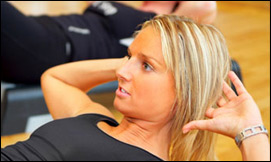Bone-strengthening exercise
Feature
Osteoporosis, a condition characterised by the loss of calcium and tissue in the bones, affects nearly half of all women and a third of men over 60 years in the western world to some degree. When bones become fragile with age, the temptation is to ease off the exercise and take things easy, but that can make the condition worse.
The risk of osteoporosis can be greatly reduced by a calcium-rich diet and regular weight-bearing exercise throughout life, particularly during childhood and adolescence. However, if you have already been diagnosed with the condition, research indicates that you can benefit from weight-bearing exercise too.
Slowing down your fitness regime and taking things easy means you are adopting a sedentary lifestyle, which actually encourages the loss of bone mass. Reliable research studies have found that sensibly exercising on a regular basis reduces the rate of bone loss and conserves remaining bone tissue.
Most bone fractures occur because of a fall. As exercise builds muscle strength and can improve balance, it is suggested that this may help reduce the likelihood of falling. A sedentary lifestyle, however, produces poor posture, poor balance and weak muscles, which is likely to increase the risk of fractures.
Finding an appropriate exercise regime depends on your age, the severity of your osteoporosis, your fitness level and any other medical conditions that may affect your physical health such as heart disease, diabetes or arthritis. Your doctor or physical therapist can help you decide what activities are best for you.
However, as a general rule, exercises ideal for osteoporosis sufferers include walking, Tai Chi, low impact aerobics, weight training with free weights, resistance training using rubber tubes and exercises to improve posture, balance and body strength.
Exercises with a high risk of fractures should be avoided, including any high-impact activities, any exercise that requires sudden forceful movement, exercise that requires a twisting motion, such as a golf swing, and exercise requiring sudden stops and starts, such as tennis.
Current research suggests that osteoporosis sufferers benefit from 30 minutes to one hour of continuous aerobic activity two to three times per week. Strength training should be performed twice a week and balance exercises should be performed for a few minutes at least twice a week. Fitness experts also recommend that you complete stretching exercises every day to promote flexibility and a pain-free range of motion. However, always consult your doctor before embarking on a new fitness regime. 

A guide to theraputic treatments
Ayurvedic Detox
Essential oil special
Beauty Tips
Herbs for Hair
The Power Of Aromatherapy Soap
Nails made easy
Hints & Tips
Celebrity Diet Secrets
Water, the Ultimate Detox Tool
Glowing skin
Nutrition
The beauty of raw food
Diet Truth
Dieting A-Z
Complementary Health
Beautcamp Pilates
Photo gallery: Ashtanga Yoga
Top mind and memory boosters
Feeling good and looking good
Help from the Dead Sea
Beauty and the berry
The beauty of pentapeptides
Features
Giving Up Smoking
Toxins: Where Do They Come From?
Bone-strengthening exercise
Pregnancy
Fishy facts for mums-to-be
Pregnancy skin care
Calm infertility stress with yoga at home





